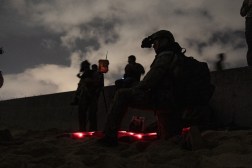New Marine Corps information command seeks to better link theater forces to the joint force

A forthcoming command announced by the commandant of the Marine Corps aims to more tightly link the service’s information forces in theater with the broader joint force across the globe.
The Corps intends to create a Marine Corps Information Command (MCIC), according to the annual update to Gen. David Berger’s Force Design 2030, released Monday.
Given the global nature of the information environment, the Corps believes it will need to better link its tactically focused forces and capabilities in theater with other military units across theaters.
“We believe that in a conflict with a peer adversary, first moves may be in space and cyber, so we must enable our Stand-in Forces, MEUs, and MEFs to integrate with, and have access to, those capabilities now,” the document says, referencing Marine expeditionary units and expeditionary forces.
This new command will streamline and coordinate authorities for forces as well as requirements in theater, according to Lt. Gen. Matthew Glavy, deputy commandant for information.
“The Marine Corps as a stand-in force, based on its ability to maneuver, based on its placement and access has game here,” he said during a presentation at the Modern Day Marine conference on Wednesday. “There’s opportunity for the Marine Corps to enable the joint force in such a way to gain advantage. This idea of the MCIC is trying to streamline.”
At the joint level, there are a lot of authorities that have to be coordinated, especially in the non-kinetic and digital realm as it pertains to intelligence collection — which is very heavily regulated under spying authorities known as Title 50 — and operations within cyberspace and the electromagnetic spectrum meant to disrupt an adversaries operations, known as Title 10 or general warfighting authorities.
In many cases, the lines between these disciplines can be blurred given how closely related their actions are.
Unlike in Hollywood, cyberspace operations or operations in the electromagnetic spectrum aren’t as easy as pushing “Enter” on keyboard, In order to be successful in these highly technical operations, forces must be forward and present to gain the necessary access for intelligence collection to map and understand systems and signals, and eventually affect systems if the go-ahead is given.
“If you’re not touching, integrating, intimate in those authorities, you’ll be left out. The idea of this MCIC is … taking advantage of all that in order to provide the depth and breadth to be this enabler of the joint force out on the edge based on where we are living in the weapons engagement zone,” Glavy said. “If you’re not where those authorities are — like space, like cyber, like the intel community, Title 50 authorities — if you’re not there you’re probably going to be hard pressed to get there.”
The Force Design document notes that the Corps has learned that access and placement matter and assigning liaison officers within naval, joint and combined organizations with authorities and permissions will allow them to gain kill web tempo and agility.
“We can streamline and simplify much of the coordination burden at the headquarters level if we re-organize and re-focus some of our structure, which we will do in the future with the creation of the Marine Corps Information Command,” the document says.
Glavy clarified to FedScoop following his remarks that this command, which is still pre-decisional, will help to coordinate these intelligence and warfighting capabilities across the Marine Corps’ tactical formations and gain symmetry with the joint force.
It will also facilitate requirements the MEFs may have that fall outside the scope of their specific combatant commands, he added.






